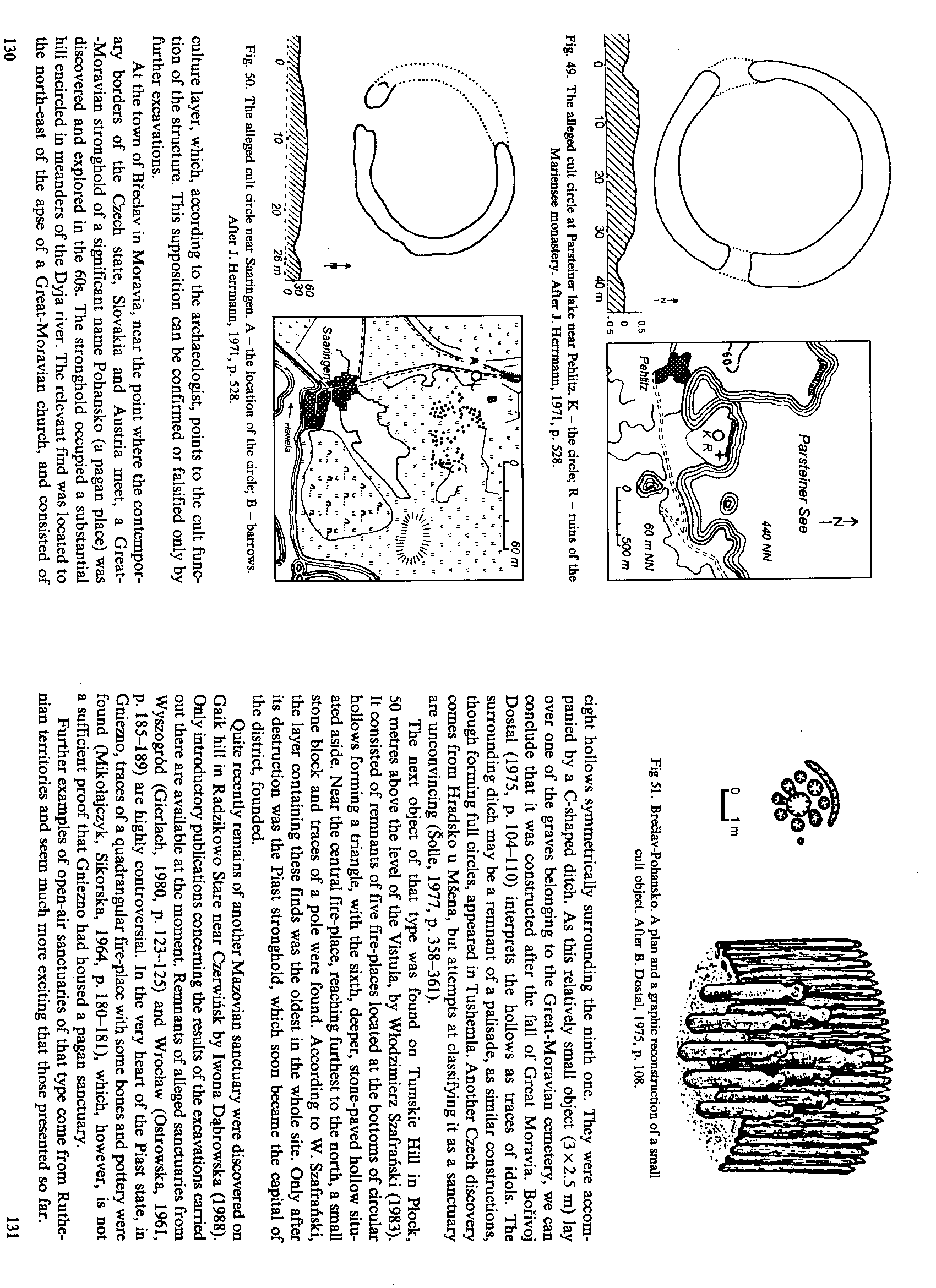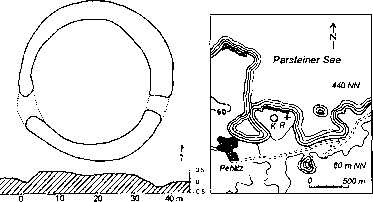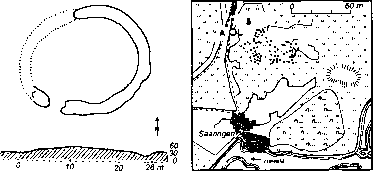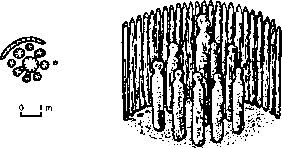image064


Fig. 49. The alleged cult circle at Parsteiner lakę near Pehlitz. K - the drcle; R - ruins of the Mariensee monastery. Aft er J. Herrmann, 1971, p. 528.

Fig. 50. The alleged cult circle near Saaringen. A - the location of the drcle; B - barrows. After J. Herrmann, 1971, p. 528.
culture layer, which, according to the archaeologist, points to the cult func-tion of the structure. This supposition can be confirmed or falsified only by further excavations.
At the town of Breclav in Moravia, near the point where the contempor-ary borders of the Czech State, Slovakia and Austria meet, a Great--Moravian stronghold of a signiflcant name Pohansko (a pagan place) was discovered and explored in the 60s. The stronghold occupied a substantial hilł encircled in meanders of the Dyja river. The relevant flnd was located to the north-east of the apse of a Great-Moravian church, and consisted of

Fig SI. Breclav-Pohansko. A plan and a graphic reconstruction of a smali cult object. After B. Dostał, 1975, p. 108.
eight hollows symmetrically surrounding the ninth one. They were accom-panied by a C-shaped ditch. As this relatively smali object (3x2.5 m) lay over one of the graves belonging to the Great-Moravian cemetery, we can conclude that it was constructed after the fali of Great Moravia. Bofivoj Dostał (1975, p. 104-110) interprets the hollows as traces of idols. The surrounding ditch may be a remnant of a palisadę, as similar constructions, though forming fuli circles, appeared in Tushemla. Another Czech discovery comes from Hradsko u Msena, but attempts at classifying it as a sanctuary are unconvincing (Solle, 1977, p. 358-361).
The next object of that type was found on Tumskie Hill in Płock, 50 metres above the łevel of the Yistula, by Włodzimierz Szafrański (1983). It consisted of remnants of five fire-places located at the bottoms of drcular hollows forming a triangle, with the sixth, deeper, stone-paved hollow situ-ated aside. Near the central ftre-place, reaching furthest to the north, a smali stone błock and traces of a pole were found. According to W. Szafrański, the layer containing these finds was the oldest in the whole site. Only after its destruction was the Piast stronghold, which soon became the Capital of the district, founded.
Quite recently remains of another Mazovian sanctuary were discovered on Gaik hill in Radzikowo Stare near Czerwińsk by Iwona Dąbrowska (1988). Only introductory publications conceming the results of the excavations carried out there are available at the moment. Remnants of alleged sanctuaries from Wyszogród (Gierlach, 1980, p. 123-125) and Wrocław (Ostrowska, 1961, p. 185-189) are highiy controversial. In the very heart of the Piast State, in Gniezno, traces of a ąuadrangular fire-place with some bones and pottery were found (Mikołajczyk, Sikorska, 1964, p. 180-181), which, however, is not a sufficient proof that Gniezno had housed a pagan sanctuary.
Further examples of open-air sanctuaries of that type come from Ruthe-nian territories and seem much morę exciting that those presented so far.
131
Wyszukiwarka
Podobne podstrony:
image090 Fig. 73. The alleged sanctuary on Bogit mountain. The stronghold. The cult circle. The alle
image083 Fig. 67. The enthroning ceremony of a Carinthian prince on an engraving from Osłerreichisch
image089 Fig- 71. The stoi»e walls around the peak of Góra Dobrzeszowska. 1 - the internal wali; 2 -
image094 Fig. 75. The Krak Mound near Cracow. Photo L. Słupecki. is banished, and as the małe linę i
image017 Fig. 10. The plan of the stronghold m Arcona reconstructed by H.Berlekamp and J.Herrmann. A
image042 Fig. 18. The topography of the early-raedjevaj Wolin. A - the presumed location of the temp
image047 Fig. 22. The location of the stronghold in Gross Raden. 1 - the stronghold in Gross Grónow;
image049 1 m Fig. 26. The profile and plan of the remains of Ihe south-ea&tem wali base of the t
image078 Fig. 66. The sanctuary in Rzhavintse. Top: a plan of the stronghold with sounding excavatio
image023 Fig. 15. Korzenica-Garz. I, II, m - the alleged traces of temples in the stronghold; after
image038 Fig. 17. Szczecin. The town arrangement in the earlier MiddJe Ages. 1 - the stronghold at t
image063 Fig. 47. Trzebiatów. A plan of the town and its surroundings. A - the cult place on David H
image065 Fig. 52. Płock. The alleged pagan sanctuary, excavation site 3 (in Ihe abbey yard), layer V
image077 Fig. 64. Gniloy Kut near Grodek Podolsky. A plan and profile of ”the cult yard” or altar. 1
image038 a Fig 10 Idea of the “World tree" as the “World axis" implemented m settlements o
Fig. 5. Calculated heat losses (q2.q3.qi, qs) vs. stcam power for three levels of sloichiometric rat
290 (36) 262Dress Accessońes 1354 SWA81 542 (2012) 11 fig 169 d 30mm; fleur de lis at the end of eac
image092 a rotunda under the invocation of St George sińce 1126 (earlier possibly of St Adalbert), e
więcej podobnych podstron